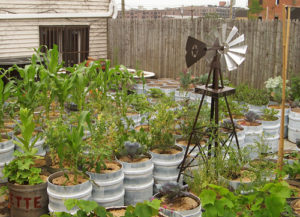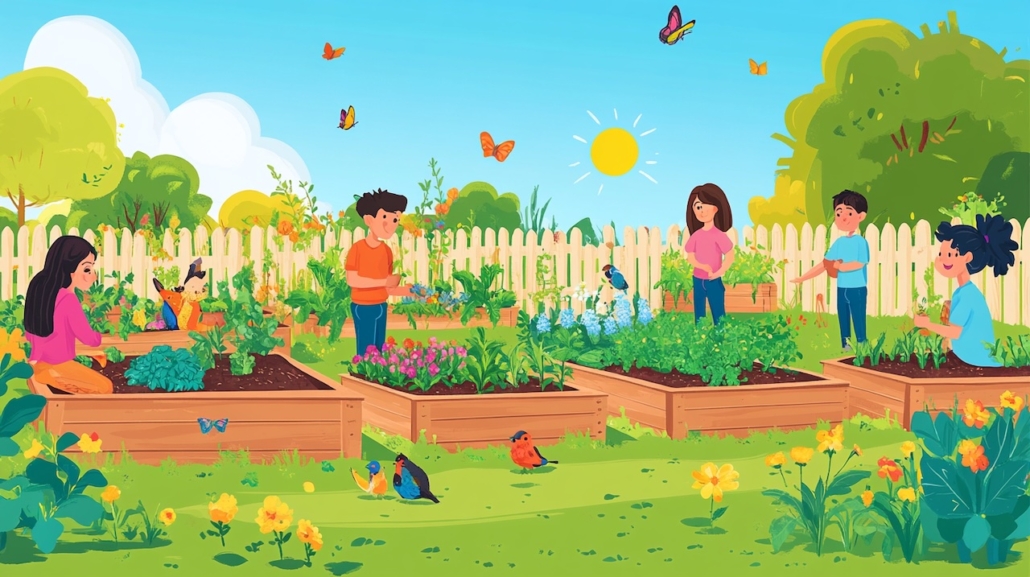Secrets of starting a no-fuss garden on time
 by Emily Cates
by Emily Cates
Attention slackers and Free-gans this one’s for all of us! Do you want a garden but you’re putting it off for the last moment? Lack of time? No problem. Lack of space? Don’t worry. Too expensive? No way! Not enough motivation?
We’ll do our best. Whatever the reason for procrastination, there are compelling reasons to get outside and “just do it.” After all, the more you put into the garden, the more you’re likely to get out of it. Well – to a point. You see, there are a few hints and shortcuts that might be of interest and easier on our wallets. Follow along as we look at ways to make the most out of our time in the dirt. We’ll look at garden cleanup, soil preparation, inexpensive seeds and starts, and a weeding method that can make a lazy gardener’s dreams-come-true. And we’ll do this in the spirit that anyone, anywhere, regardless of time and finances, might just be able to grow something this year.
First things first, though. When it comes to cleaning up the garden space, there’s no going around it; In this case procrastination will waste time! A garden that is free from crop remains will be a real time-saver when it comes to dealing with pests and pestilence. While the best time to clean up the garden was probably last fall, nothing should hold us back from ensuring it gets done now. Pull up and destroy any annual plants lingering from last year, as bugs and diseases potentially lurk in their presence. Even if you need to work in 10 minute increments, make sure to do this before it greens up outside.
When clean-up has been satisfactorily accomplished, then it’s time to prepare the soil. Is lack of space holding you back? Why not garden in containers? A tub full of soil on the patio or a window box can grow more than you think, especially when growing cultivars bred specifically for containers. Think tomatoes, cukes, greens, herbs, beans, and more. (Just don’t forget to keep it watered.)
As with cleanup, putting off preparing the soil will only make more work in the future when weeds will have taken hold. Now, there are scores of ways to do this – from thorough tilling of the soil by hand or with equipment – or “lasagna” style by piling on layers of organic matter and mulches. I can’t tell which one is best, because it all depends on the plot. What I can tell you is that I believe the best methods for soil preparation involve adding organic matter, a little more than what was taken out before. Depending on the richness of  the ground, I tend to add enough to darken the soil a few shades. Compost from kitchen scraps, leaves, livestock bedding or manure are low-cost and effective soil amendments. Oftentimes, compost may also be obtained from the local transfer station. It might be worthwhile to call around to local farms to see if they have manure available.
the ground, I tend to add enough to darken the soil a few shades. Compost from kitchen scraps, leaves, livestock bedding or manure are low-cost and effective soil amendments. Oftentimes, compost may also be obtained from the local transfer station. It might be worthwhile to call around to local farms to see if they have manure available.
Regarding soil prep, it’s easiest to do when the spot was heavily mulched the previous fall. Then the mulch can just be pulled back in the springtime, and voila! A shovelful here and there of organic matter to darken up the soil, a little digging with a spading fork to mix it in and till, might be all that’s needed to be ready to plant.
Seeds are an economical way to get a garden going, especially if they were saved from our own garden. Seed swaps and seed libraries are a great place to obtain seeds, and are an excellent option when price is an issue. Veggie seeds and transplants can also be purchased with EBT benefits – check Hannaford and Uncle Dean’s. Also, many greenhouses donate their surplus to food banks instead of just throwing them out. These plants might be a bit leggy, but with proper care, may provide many nutritious and delicious meals.
Does the thought of weeding deter you from gardening? Save time and energy by smothering them early on with mulch. Un-colored newspaper and untreated cardboard are good choices for mulches since they are usually free at the transfer station. I lay them down and cover with old sawdust or debris left over from my firewood pile. I find this especially works well for permaculture.
And now, the secret for a no-fuss garden you’ve all been waiting for. Well, actually, it’s not much of a secret. Look at the forest floor and you’ll get an idea how Nature does it. Pick up a handful next time you’re in the woods and see how the soil is nice and rich, without many weeds. What a wonderful smell! So alive, full of nutrients, and little creatures – like a mini universe in the ground. This is the color I think our garden soil should be. So what’s the secret? Leaf mulch. As the trees shed their leaves, they layer the forest floor with nutrition that was drawn up from way below the ground. I find that the closer I emulate these conditions in my own garden, the healthier the soil and resulting plants. Not to mention far fewer weeds. So I try to incorporate well-rotted leaves whenever I can. Starting a leaf pile may be easier than you think, since bags of leaves are oftentimes found roadside and free for the taking. Check the transfer station, too.
Now we’ve eradicated the top excuses for not having a garden this year! See you at the FEDCO Tree Sale May 6 and 7.
Responsible journalism is hard work!
It is also expensive!
If you enjoy reading The Town Line and the good news we bring you each week, would you consider a donation to help us continue the work we’re doing?
The Town Line is a 501(c)(3) nonprofit private foundation, and all donations are tax deductible under the Internal Revenue Service code.
To help, please visit our online donation page or mail a check payable to The Town Line, PO Box 89, South China, ME 04358. Your contribution is appreciated!



Leave a Reply
Want to join the discussion?Feel free to contribute!